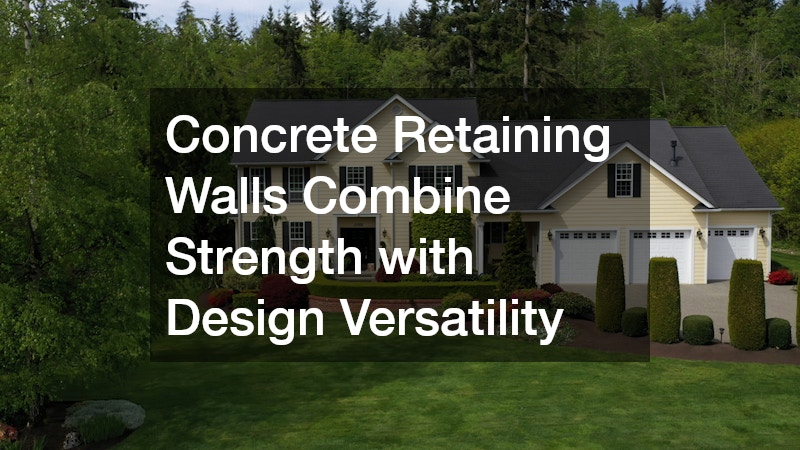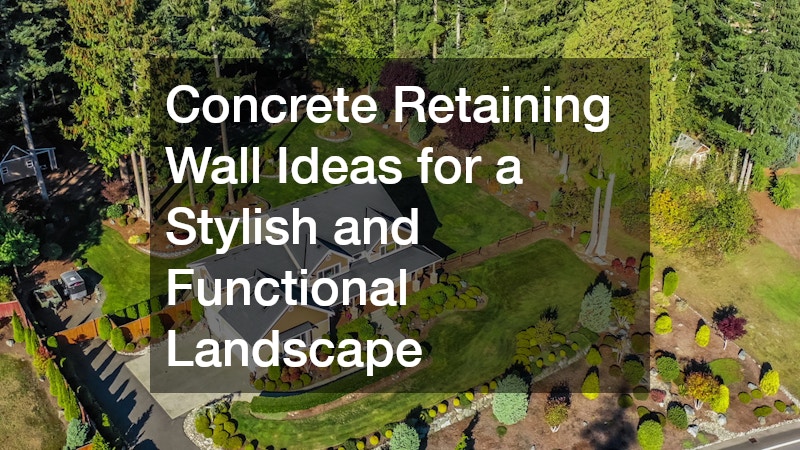Explore how concrete retaining walls can enhance your landscape, blending style with functionality. Understand various design options, construction tips, and maintenance advice to ensure long-lasting beauty and stability.
1. What Are the Benefits of Using Concrete for Retaining Walls?
1.1 Durability and Strength
Concrete is known for its longevity and ability to withstand harsh environmental elements, making it a reliable choice for retaining walls. Its inherent strength makes it an ideal material for supporting the earth and resisting pressure from retaining large volumes of soil.
Concrete walls can last for decades with minimal maintenance, which further underscores their value. Investing in a concrete retaining wall can thus be a cost-effective solution over time due to its durable nature.
One of the key advantages of concrete is its flexibility in adapting to demanding environmental conditions. This resilience ensures that the structural integrity of the wall is maintained even in adverse weather, providing peace of mind for homeowners.
1.2 Versatility in Design
Discuss the wide range of design possibilities with concrete, from traditional smooth surfaces to textured finishes that mimic natural stone or wood. This versatility allows for customization, catering to both minimalist modern designs and more rustic, natural appearances.
Concrete retaining walls can be fashioned into various shapes and curves, enabling complex landscape designs. By using stamping or staining techniques, the surfaces can depict high-end visuals, enhancing the wall’s aesthetic appeal.
Such design flexibility makes concrete an ideal choice for those looking to incorporate unique and personalized elements into their landscape. The adaptability also means that homeowners are not limited by existing styles and can freely mold the landscape’s flow as desired.
2. How Can You Incorporate Style into Concrete Retaining Walls?
2.1 Color and Finish Options
Explore the various color options and finishes available for concrete, allowing customization to match existing landscapes or create bold contrasts. Concrete stains and dyes can provide vibrant color finishes, while integral coloring is utilized for softer, more subdued tones.
Finishes vary from smooth and polished surfaces to aggregate finishes that reveal the texture of mixed materials within. For those seeking elegant outcomes, exposed aggregate finishes can offer a sophisticated and natural look.
Choosing the right color and finish can transform the retaining wall from just a functional structure into a piece of art that enhances the curb appeal. Homeowners should consider the overall theme and color palette of their landscape when selecting options.
2.2 Integrating Plants and Lighting
Learn how to incorporate greenery and lighting into your concrete retaining wall design to enhance both aesthetics and functionality. By strategically placing plants within built-in planters, the hard and soft elements of the landscape can be seamlessly integrated.
Lighting features such as LEDs or solar lights can be added to the wall, creating visual interest and providing illumination for safety during evening hours. This dual-purpose approach enhances the usability of outdoor spaces while emphasizing architectural elements.
Incorporating eco-friendly practices, like using native plants or energy-efficient lighting, can further the appeal of the retaining wall. Whether aiming for minimalism or lush greenery, these design choices impact not just the wall but the complete ambiance of the area.
3. What Are the Best Practices for Constructing and Maintaining Concrete Retaining Walls?
3.1 Construction Tips
Provide detailed construction guidelines to ensure a sturdy and safe retaining wall, including considerations for drainage and reinforcement. Proper drainage is crucial to prevent water pressure build-up behind the wall, which can compromise its stability.
Reinforcement with steel bars or wire mesh is often necessary to increase the structural integrity, especially for walls supporting heavy loads. Specialist contractors can also help account for any unique soil conditions or site-specific variables that could affect wall performance.
Ensuring the foundation is solid and level is the first step towards a successful build. This foundation will serve as the base upon which the dependability and durability of the entire structure rests.
3.2 Maintenance Strategies
Discuss periodic maintenance practices necessary to prolong the life of your retaining wall and keep it looking its best. Regular cleaning, sealing, and inspection are key to preventing and addressing any minor issues before they escalate into major repairs.
Sealing the concrete can protect the surface from moisture and potential staining, thereby maintaining its aesthetic value. Visual inspection helps identify cracks or signs of wear that may need prompt attention to maintain structural integrity.
Given the long lifespan of concrete structures, a sound maintenance plan is an investment worth making. Routine evaluations ensure that both the functionality and beauty of the wall are preserved through the years.
Summarize the importance of planning, design choices, and regular maintenance in creating a concrete retaining wall that is both stylish and functional, enhancing the overall landscape aesthetics and usability. Attention to detail in construction and upkeep can provide lasting benefits.
Concrete retaining walls merge the worlds of form and function, offering robust support as well as design versatility. With thought-out integration of plants, lighting, colors, and finishes, these structures can redefine a property’s design landscape beautifully and effectively.




